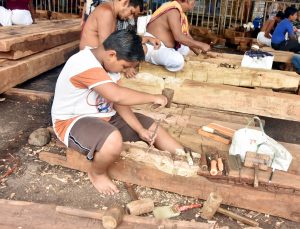Rath Yard turns into ‘gurukul’ for little artisans

Puri: With the Rath Yatra approaching fast, construction of the chariots for the Trinity is in full swing at the temporary Rath Yard near Srimandir. The rhythmic sounds of chisels and mallets from the skilled hands of Vishwakarma Maharana servitors fill the air, creating a devotional ambience.
Amidst the hectic work, one scenario that catches the attention is the tiny Rupakar servitors being mentored by the senior servitors at the Rath Yard, which resembles a traditional ‘gurukul’.
Undeterred by the scorching sun or even sudden showers, every artisan — young and old — is deeply immersed in the sacred task of building the Lord’s chariots. According to Rath Samhita, servitors known as Rupakars (sculptor-artisans) traditionally enter the Rath Yard on Nrusingha Chaturdashi to begin engraving and carving divine motifs onto the wooden components of the chariots. This space gradually transforms into a traditional learning ground or ‘gurukul’ for their children.
Boys aged between 11 and 13 years accompany their elders to the workshop — not to play, but to learn. Hammer and chisel in hand, they contribute to the making of the majestic chariots under the watchful eyes of their mentors.
Children of various servitor families — carpenters, blacksmiths, tailors, painters, and sculptors — join the workshop each year to gain hands-on experience in traditional craftsmanship. These young apprentices carve intricate designs of Singha Biral, Nara Biral, Gaja Biral, and Nata Ghoda, among others. The effort is part of an age-old tradition to pass down the legacy of temple service from father to son. Under the magical touch of their small hands, lifeless wood seems to come alive.
The Rupakar servitors are also responsible for a wide range of wooden sculptures for the Srimandir—from Konagujas and Patagujas to images made for Nabakalebara like side deities, charioteers, horses, pots, companions, and parrots.
Their craft goes beyond wood, extending to brass, gold, silver, and other metals, producing lifelike creations that are revered by devotees. With a commitment to preserving the legacy inherited from their ancestors, today’s artisans are ensuring that this sacred tradition endures.
Their skill and dedication are now recognised far and wide, and the younger generation of Rupakars take immense pride in calling themselves the servitors of Lord Jagannath.
PNN
News